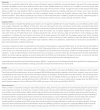Inpatient care of small and sick newborns: a multi-country analysis of health system bottlenecks and potential solutions
- PMID: 26391335
- PMCID: PMC4577807
- DOI: 10.1186/1471-2393-15-S2-S7
Inpatient care of small and sick newborns: a multi-country analysis of health system bottlenecks and potential solutions
Abstract
Background: Preterm birth is the leading cause of child death worldwide. Small and sick newborns require timely, high-quality inpatient care to survive. This includes provision of warmth, feeding support, safe oxygen therapy and effective phototherapy with prevention and treatment of infections. Inpatient care for newborns requires dedicated ward space, staffed by health workers with specialist training and skills. Many of the estimated 2.8 million newborns that die every year do not have access to such specialised care.
Methods: The bottleneck analysis tool was applied in 12 countries in Africa and Asia as part of the Every Newborn Action Plan process. Country workshops involved technical experts to complete the survey tool, which is designed to synthesise and grade health system "bottlenecks" (or factors that hinder the scale up) of maternal-newborn intervention packages. For this paper, we used quantitative and qualitative methods to analyse the bottleneck data, and combined these with literature review, to present priority bottlenecks and actions relevant to different health system building blocks for inpatient care of small and sick newborns.
Results: Inpatient care of small and sick newborns is an intervention package highlighted by all country workshop participants as having critical health system challenges. Health system building blocks with the highest graded (significant or major) bottlenecks were health workforce (10 out of 12 countries) and health financing (10 out of 12 countries), followed by community ownership and partnership (9 out of 12 countries). Priority actions based on solution themes for these bottlenecks are discussed.
Conclusions: Whilst major bottlenecks to the scale-up of quality inpatient newborn care are present, effective solutions exist. For all countries included, there is a critical need for a neonatal nursing cadre. Small and sick newborns require increased, sustained funding with specific insurance schemes to cover inpatient care and avoid catastrophic out-of-pocket payments. Core competencies, by level of care, should be defined for monitoring of newborn inpatient care, as with emergency obstetric care. Rather than fatalism that small and sick newborns will die, community interventions need to create demand for accessible, high-quality, family-centred inpatient care, including kangaroo mother care, so that every newborn can survive and thrive.
Figures








References
-
- UN-IGME. Levels and trends in child mortality: Report 2014. New York, USA: UN-Interagency group for child mortality estimation; 2014.
-
- Lee AC, Katz J, Blencowe H, Cousens S, Kozuki N, Vogel JP. et al. National and regional estimates of term and preterm babies born small for gestational age in 138 low-income and middle-income countries in 2010. The Lancet Global Health. 2013;1(1):e26–e36. doi: 10.1016/S2214-109X(13)70006-8. - DOI - PMC - PubMed
-
- Katz J, Lee AC, Kozuki N, Lawn JE, Cousens S, Blencowe H. et al. Mortality risk in preterm and small-for-gestational-age infants in low-income and middle-income countries: a pooled country analysis. Lancet. 2013;382(9890):417–25. doi: 10.1016/S0140-6736(13)60993-9. Epub 2013/06/12. - DOI - PMC - PubMed
-
- Blencowe H, Cousens S, Oestergaard MZ, Chou D, Moller AB, Narwal R. et al. National, regional, and worldwide estimates of preterm birth rates in the year 2010 with time trends since 1990 for selected countries: a systematic analysis and implications. Lancet. 2012;379(9832):2162–72. doi: 10.1016/S0140-6736(12)60820-4. - DOI - PubMed
MeSH terms
Substances
LinkOut - more resources
Full Text Sources
Medical
Molecular Biology Databases

